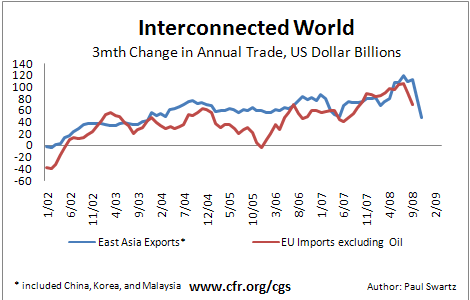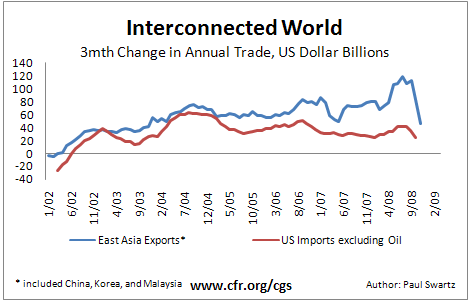Chieuropa?
More on:
The thesis that China and America should be viewed as a single economy – or at least as a single currency area – is due for a comeback.
After flirting with change, the RMB is once again pegged tightly to the dollar. 6.85 is the new 8.27. I would not be surprised if China’s external surplus and the United States deficit prove to be roughly equal in size in 2009 The obvious argument is that while the US runs a big deficit, Chimerica doesn’t. East Chimerica’s surplus offsets West Chimerica’s deficit. No worries. At least so long as China’s government is willing to finance the US.
The fact that the Chimerican currency union required unprecedented growth in China’s reserves was always my main objection to the Chimerica thesis. A currency union in theory shouldn’t require that kind of government intervention to keep in balance.
But Chimerica never was really financially integrated. Back when the RMB was (correctly) considered a one way bet, China erected capital controls to keep American (and other) capital from speculating on its currency. And for most of this decade, the net outflow from China to America came not from a desire on the part of Chinese savers to hold dollars but rather from a desire of China’s government to hold the Chinese currency down against the dollar. That policy required that China buy dollars in the foreign exchange market, and in the process finance the US deficit.
However, another objection may be more important. The argument that Chinese and America formed a perfect union – with US spending generating demand to offset Chinese savings, and Chinese savings financing the borrowing associated with US spending – hasn’t quite worked for the past couple of years. It leaves out Europe. And Europe, not the US, was the big spender in the world economy in 2006, 2007 and the first part of 2008.
My colleague at the Council’s Center for Geoeconomic Studies, Paul Swartz, has produced a clever graph (available on the CGS website) showing that the growth in Asian exports hinges on the growth in US and European imports. Makes sense. Paul also plotted Asian export growth against American import growth and European import growth separately -- and the chart of European import growth against Asian export growth highlights just how large Europe’s contribution to Asian export growth has been recently.
This shouldn’t be a surprise. The depreciation of the Japanese yen and Chinese yuan against most European currencies over the past several years (and yes, I know that things changed in the past few months) was the big currency move of the past several years – at least as economically significant as the depreciation of the dollar against the euro. That depreciation produced the expect result: a surge in European imports from Asia, and a big increase in Europe’s deficit with Asia in general and China in particular.
That is a clear change from earlier this decade. Back in 2003 and 2004 and even 2005, it really was the US consumer that was driving the expansion of global demand.
The coupling of China’s export machine to European demand explains why China’s exports and surplus were both able to increase over the past couple of years even thugh the US non-oil deficit peaked in late 2005/ early 2006. It doesn’t take that much leg work (the data tables at the end of the IMF’s World Economic Outlook are always a good place to start … ) to figure out that a swing in Europe’s current account balance made this possible.
Let’s say that the US runs a $500 billion current account deficit next year, and the United States’ bilateral deficit with China is around $250 billion. Let’s also assume that China runs a $500 billion current account surplus next year (that makes the math easy – and it isn’t out of line with China’s November trade surplus). That implies that China is running a big surplus with the world not just the US. And Chimerica only works, in some sense, if China lends the (large) surplus it earns with the non-Chimerican world (and Europe in particular) to the US, allowing the US to run a deficit with the non-Chimerican world.
To make everything (too) neat, let’s assume China runs a $250 billion surplus with Europe and its trade with the rest of Asia and the oil exporters is balanced. And let’s assume that Europe runs a $150 billion surplus with the US and a $100 billion surplus with the oil exporters (offsetting its deficit with China) – and that the US has a $150 billion deficit with Europe and a $100 billion deficit with the oil exporters.
That simplifies a lot. It leaves out private inflows and outflows for one, which can drive China’s reserve growth above or below its current account surplus. It also leaves out Chinese purchases of European assets and European purchases of US assets. It ignores intra-European flows – and reduces Asia to China.
But it captures something important as well. China’s surplus can expand even in the absence of a rise in the United States deficit if Europe’s deficit rises, for one. And in my little thought experiment, the global flow of funds only balances if China lends its surplus with Europe to the US.
Or, to put it a bit differently, if Chieuropa lends to the US …
More on:
 Online Store
Online Store

